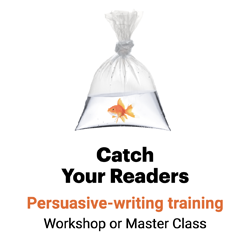Translate features to advantages to benefits
Quick! Which would you rather have: Apple’s new incredibly responsive A9X chip? Or the ability to perform complex jobs like editing 4K video quickly and smoothly via your iPad?

And that’s the problem.
Your readers don’t care about your organization and its stuff. They care about themselves and their needs.
So to sell your products, services and ideas, you need to show how your organization and its stuff can fill your readers’ needs. One way to do that: Translate your message from features into advantages into benefits.
| Translate from features into advantages into benefits | |||
| Feature What it is |
Advantage What it does |
Benefit What it will do for you |
|
| Definition | An attribute of your product, service, program or idea | The reason the feature is important | What the feature will do for you |
| Example | The new iPad Pro features Apple’s new A9X chip. | The A9X chip is incredibly responsive. | That means you can perform complex jobs like editing 4K video quickly and smoothly on your iPad. |
| Type of word | Noun | Adjective or adverb | Verb |
| Problem | People don’t buy features — not on chairs, in products and services or in information. So you need to keep translating. | People don’t buy advantages, either. So you need to keep translating. | People do “buy” benefits, in products, services or information. |
So don’t sell me a MacBook Air. Sell me on the time I’ll save with the Air.
The problem is, most readers can’t get from “AX9 chip” to “perform complex jobs like editing 4K video” by themselves. In fact, sales research tells us that some 70% of our readers can’t translate from advantages to benefits without help, says Linda Miller, president of The Marketing Coach.
So don’t rely on your readers to translate. That’s your job.
Lead with the benefits.
Once you’ve identified your features, advantages and benefits, you’ll want to lead with the benefits and substantiate with the features. (Or, as my clients at Verizon Wireless say, “We’ve been doing a lot of B-A-F-ing.”)
That means you’ll focus on your reader’s needs first, then follow up with your organization and its stuff.
Here’s how it looks, with examples from Apple’s latest iPad promo:
- [Benefit] View movies that look like the big screen on the small screen with [Feature] our new display, which uses the same color space as the digital cinema industry. With [Feature] 25% greater color saturation than previous iPad models, colors are more [Advantages] vivid, true to life and engaging.
- [Benefit] Perform complex jobs like editing 4K video quickly and smoothly with the new iPad Pro’s [Advantages] incredibly responsive [Feature] A9X chip.
- [Benefit] Lose yourself in your favorite apps and games, thanks to our [Advantages] graphics performance. [Feature] With double the graphics performance of iPad Air 2, iPad Pro offers [Advantages] detailed visuals, fluid animations and like-real effects.
- [Benefit] Shoot beautiful photos and video with our [Feature] 8-megapixel iSight camera. [Benefit] You’ll always look great thanks to True Tone flash, [Feature] which captures real skin tones in every kind of lighting.
- [Benefit] Shoot beautiful photos and video with our [Feature] 8-megapixel iSight camera. [Benefit] You’ll always look great thanks to True Tone flash, [Feature] which captures real skin tones in every kind of lighting.
How can you sell your organization and its stuff by focusing first on your readers and their needs?

Leave a Reply